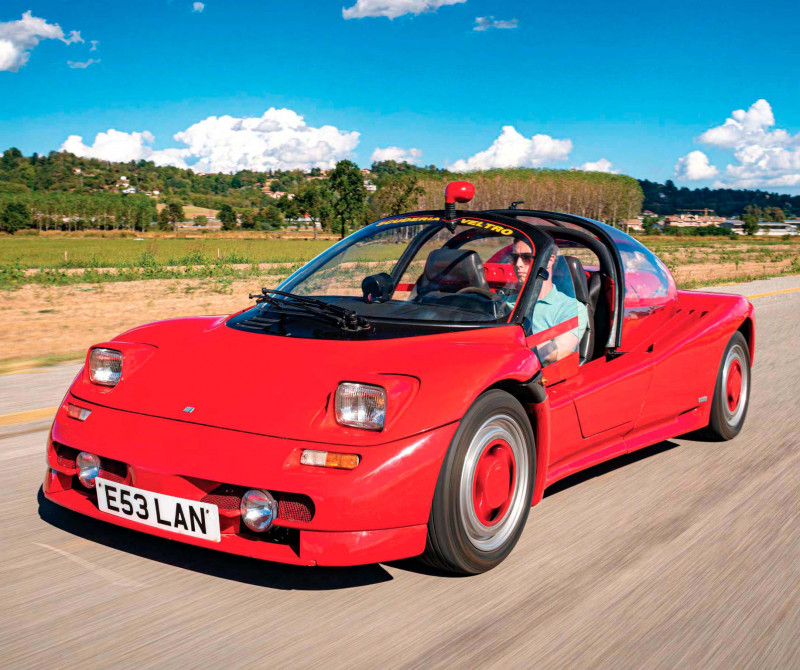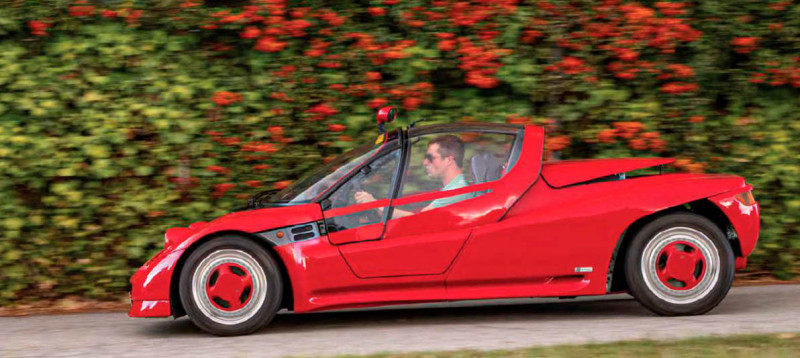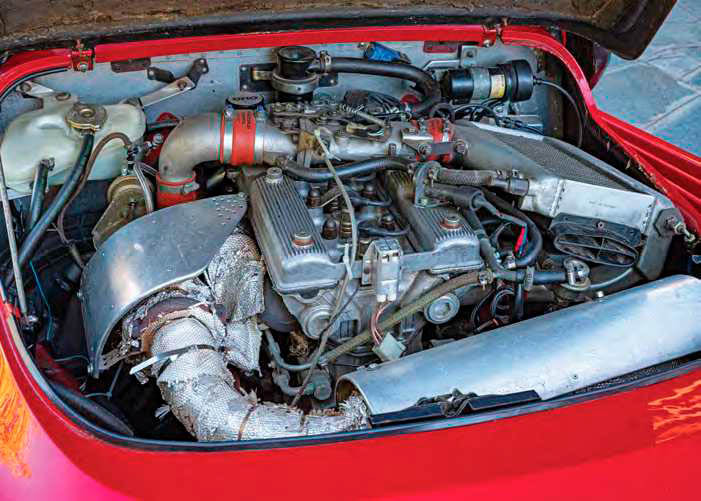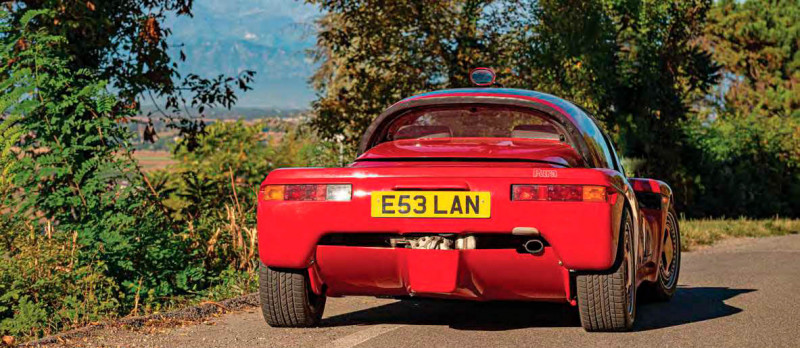1988 Michelotti Pura - we drive an Alfa 75 Turbo-powered one-off
What would a 1980s sports car have been like with radical carbonfibre construction, Alfa Romeo turbo power and racing push-rod suspension? We drive the one and only Michelotti Puraprototype to find out.
Pura Pleasure
Story by Aaron McKay
Images by Gregory Owain
By its diminutive shape and innocent eyes, it could easily be mistaken for a Japanese ‘Kei’ microcar with a 6600cc, 64bhp engine. It does have a Japanese connection but it’s very much not a Kei car: instead it has an Alfa Romeo 75 Turbo engine. Getting inside the 3560mm long, remarkably low car – just 1300mm tall – you have to overcome a wide carbonfibre sill to reach a seat that seems hardly more than an inch off the ground. Right hand on the rollover bar, right foot in, then left hand on the rollover bar and twist, lowering yourself into the snug seat.

This is clearly a car that means business. The next indication is the dominant tachometer, positioned so that the redline is at the 12 o’clock position. Then you fire up the engine and any idea that this is a cute puppy dog flies out of the window. It growls and burbles with savage intent, with a tone closer to a race car than a titchy Japanese plaything. As you set off, the turbo whistles and echoes through the exhaust with each prod of the throttle.
This is the Michelotti Pura. There are many remarkable features about it, which made it something of a sensation at the 1988 Turin Motor Show and, today, make it a part of sports car history. Built around a pioneering carbonfibre-and-aluminium honeycomb tub, the Pura mounts its 1779cc four-cylinder, turbocharged Alfa 75 engine longitudinally behind the seats. At 0.5bar of boost, it produces 155hp at 5800rpm and 167lb ft of torque at 2600rpm; raise the boost and a lot more power can be unleashed. The same ZF five-speed gearbox as used in the Lancia Rally 037 is bolted directly to the rear of the engine, with a 25% limited-slip differential hooking up the rear wheels. There’s double wishbone suspension all round, using horizontal push-rod spring/damper units braced by subframes front and rear. It weighs just 650kg. The spec says race car, but it was in fact designed to be a production reality for the road.

Carrozzeria Giovanni Michelotti – by the 1980s led by Giovanni’s son Edgardo – ensured that technological advances in motor racing could be applied to a road car. This was very much a collaborative project, with Michelotti’s Japanese designer Tateo Uchida primarily responsible for the design, while Mario Colucci (cofounder of Nova-Progetti) pursued the engineering challenges with the help of Alba-Tech (another specialist company run by Giorgio Stirano of F1 engineering fame). The Pura was unquestionably well ahead of its time. The racing components were put together with clever solutions like metal fillets protecting the honeycomb panels and deformable sections in the subframes fulfilling safety and ease-of-repair requirements. In fact, the only notable safety test the Pura wouldn’t have met was the US bumper one. Just seven months after the idea was first put forward, the Pura rolled out at the 1988 Turin Show as a virtually production-ready model. It would continue the show rounds over the next couple of years.
Although its planned price of £25,000 was low compared with a £44,000 Lamborghini Jalpa, it was still twice that of a Toyota MR2. The hoped for 500-1000 units never got off the ground. Michelotti would ultimately close shop in 1993, just as the sports car market was finally heating up. Still, as a study of what could be achieved in 1988 and how quickly a new car design could be put together in production-ready form, the Pura was remarkable. Looking at it today – a miniature exotic with real, Italian racing pedigree – it’s difficult to understand who wouldn’t want a go. Shame there was only ever one prototype.

Fortunately we’re in that one prototype today, and on the flat roads of Roero in the north-west of Italy, it responds to the throttle like a race car, with its snarling engine winding up the revs with an insatiable appetite. Get past the reverse dogleg first gear and into second, I find that the easiest way to work the super-fast (1.25 turns lock-to-lock) steering rack, heavy throw gearbox and sharp pedal box is, quite simply, to gun it. With the revs up, the gears simply fall into place and the front end darts with your every thought of a direction change. The only worry is that the Pura is outrageously fast. Even with its aggressively short-ratio gearbox, feeding its addiction to rev tempts the speedo up to big speeds. Fun, but then you remember that this is a one-off.
Good job the brakes are strong. Lifted from the front of an Alfa Romeo 75, they’re ventilated discs all round using alloy callipers on bespoke hubs. Back in third gear, I’ve got another straight ahead of me and the turbo willing me on. A flex of the throttle leads another rush of turbocharged acceleration that catapults the car forwards in a blur of motion and wild gestures of the tachometer as we pick up fourth gear. The noise of the engine almost completely drowns out the tick and ping of little stones flicking up at the tub and into the wheelarches.

I’m also getting used to the Pura’s uncompromisingly firm ride. It’s clear that the damping is good, maintaining fine control even when the exceptionally tight, short-travel springs refuse to yield over bumps in the road. What’s truly remarkable is how rigid the Pura’s body feels; even when large bumps send the car partially airborne, there is not a tremor or crash to be felt or heard. It simply skips, lands and continues unperturbed.
Still, I’m worn out after just half an hour of flying along a relatively simple road in the flatlands. Despite the generous ventilation afforded by the slide-back polycarbonate canopy, I have to wipe the sweat off my brow as I contort myself out of the seat and back into reality.
Parked up at the foot of a hill for some photos, I take the opportunity to enjoy the Pura’s details. The car looks at you with innocent Fiat 127 headlights as if it has no recollection of the savagery deployed just moments ago (the lights would have been swapped for pop-ups if the car had made production). Looked at dead on, there is a flavour of motorsport about it, particularly with its wide, gaping intakes for the two intercoolers up front. From the front three-quarter angle, its wide front end pinches in just behind the front axle, presenting a carbonfibre sill section that leads up to the rear deck. The rounded polycarbonate canopy seems to be moulded like an egg into all of this, sitting a little high in the otherwise low, flat bodywork. At the rear it’s flatter still, where the canopy cuts off sharply, like a spoiler – an aerodynamic theme continued with the wraparound engine cover that can also be popped up for extra airflow. A thin strip containing Fiat Ritmo rear lights is a mere punctuation mark before the eye is drawn to the gearbox partially shrouded by the end of the Pura’s ground-effect undertrays.
The clamshell canopy is very light and slides along its rails with ease. It’s reassuring to know that both the windscreen and rear roll-over hoops are built to withstand the Pura’s full weight. The seat, made of glassfibre and trimmed in Lippen leather, is firm and supportive. Once inside you notice the exposed carbonfibre of the dashboard, broken up occasionally by plastic switchgear and air vents, and there’s a retrofit speedometer sitting on top. Carpet trims the sides of the footwells, with austere rubber mats lining the floors – again, very much a race car dressed as a road car.
One last blast, this time up the hill towards owner Tony Calo’s house. The rough tarmac here is discouraging at first, but once committed the Pura powers forwards with confidence. A single move of the steering wheel sends the nose diving into the first hairpin, quickly followed by a bootful of throttle to spin up the turbo in second gear for the exit. It scampers round and up to the next hairpin, and I think I’ve found the perfect use for the Pura: it’s a hillclimber. The road opens up with a sweeping section begging for a nudge into third. The engine blasts and echoes against the walls, drawing neighbours’ prying eyes. I ease off and let the car and local tempers cool. With the canopy in place for this last run, I’m also heated up, particularly since the air-conditioning isn’t installed.
Curious, shocking and, at times, worrying, the Pura is above all grin-inducing. Its racing car roots simply demand you drive it faster and faster, and it gets better and better. Its spirit and technological make-up predated cars like Lotus Elise, Renault Sport Spider and Alfa Romeo 4C. The grin might have been reproduced but, sadly, the Pura never was.
TECHNICAL SPECIFICATIONS MICHELOTTI PURA
- ENGINE: Alfa Romeo 1779cc 4-cyl turbo
- MAX POWER: 155hp at 5800rpm
- MAX TORQUE: 226Nm (167lb ft) at 2600rpm
- TRANSMISSION: 5-speed transaxle
- TYRES: 205/50 R15
- DIMENSIONS: 3560mm (L), 1300mm (H)
- WEIGHT: 650kg
- MAX SPEED: 140mph
- 0-62MPH: 6.0sec
Canopy slides back to allow entry and provide open-air feeling in motion. Feels raw, exciting to drive. Radical design underpinned by pioneering carbonfibre honeycomb chassis, pushrod suspension, transaxle


